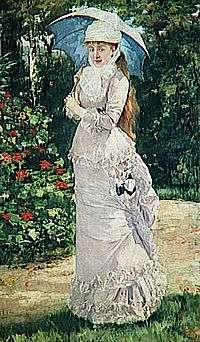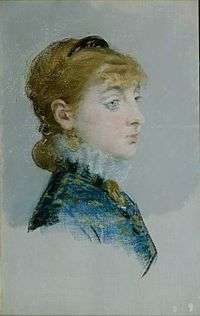Valtesse de La Bigne

Émilie-Louise Delabigne, known as countess Valtesse de La Bigne (1848, Paris – 29 July 1910,[1] Ville-d'Avray) was a French courtesan and demi-mondaine.
Life
Youth and entry into prostitution
Daughter of a violent alcoholic father and a laundry maid from Normandy who had become a prostitute, she started work in a Paris sweet-shop aged 10. She had six siblings. Aged 13, she was raped in the street by an old man. She modelled for the painter Corot, whose studio was in the district where she lived. She became a prostitute very young in the lorettes rather than the grisettes or as a courtesan. This was clandestine prostitution, often in doorways and with the risk of police arrest or having her hair shaved off as punishment.[2]
Quickly moving onto rich clients, she trained at the Bal Mabille on Sundays and worked in a women's underwear shop on the Champ-de-Mars, frequented by high-ranking officers, enabling her to dream of social climbing. There she met and fell in love with a 20-year-old man, Richard Fossey, with whom she had two children, though she continued in prostitution and Fossey left her two years later without marrying her. She entrusted her two children to her mother, but later placed one – Julia Pâquerette – in a convent, fearing that her mother had gone back to prostitution.[2]
She took the pseudonym 'Valtesse', due to its similarity to 'Votre Altesse' (your highness) – she later advised Anne-Marie Chassaigne to take a pseudonym too. She also resolved never to marry but to gain money and social position by other means. She profited from the 'brésiliens', foreign clients visiting Paris and aspired to join the 'archidrôlesses', a group of courtesans.[2]
Jacques Offenbach brought Valtesse to public attention with a small role at the Bouffes-Parisiens and proposed that she act in his productions.[2] Her debut was as Hebe in Orphée aux Enfers – one critic judged that she was "as red and timid as a virgin by Titian"
'Courtisane du Tout-Paris'

She became the composer's mistress and thus gained access to fashionable restaurants like Bignon (the former Café de Foy) or the Café Tortoni, where she met Zola, Flaubert and Maupassant. Even the starvation of the siege of Paris did not dampen her aspirations – she was made a countess by Napoleon III. Known among the Tout-Paris for his scathing humour, the journalist and writer Aurélien Scholl wrote: "During the siege of Paris, all the women ate dog. It was thought that this nourishment taught them the principals of fidelity. Not at all! They demanded necklaces!"[2][3]
At the end of the war, Valtesse quickly launched herself as a high-class courtesan, leaving Offenbach and shifting her attentions to prince Lubomirski, who installed her in an apartment in rue Saint-Georges. She wrecked it, left him and had a succession of other rich lovers, such as prince de Sagan, who she also bankrupted by having him build her a hôtel particulier designed by Jules Février between 1873 and 1876 at 98, boulevard Malesherbes, at the corner of rue de la Terrasse (destroyed and replaced by a residential block in 1904).[4]
Nicknamed 'Rayon d'or' or 'golden ray', she immersed herself in art and literature. She bought a carriage to travel round Paris and bought a sumptuous house at Ville-d'Avray, which she decorated with paintings commissions from Édouard Detaille showing fictional members of her invented 'la Bigne family'.[2] In 1876 she published an autobiographical novel entitled Isola, signed 'Ego' (her motto) – it was not a major success.[2]
At the request of Léon Hennique, she showed Émile Zola round her hôtel particulier. Her bedchamber and bed were the inspiration for those in his novel Nana: "A bed such as has never existed, a throne, an altar where Paris came to admire her sovereign nudity [...]. Along its sides, a band of cupids among flowers who look on and smile, watching the pleasures in shadows of the curtains." When she read the novel, Valtesse was indignant to find such a description of her decor – "some traces of tender foolishness and gaudy splendour".[5] and called the character of Nana (for which she was the inspiration) "a vulgar whore, stupid, rude!". Zola was still luckier than Alexandre Dumas fils – when the latter asked to enter her bedroom, she coldly replied "Dear sir, it's not within your means!"[6]
Artists' friend

Henri Gervex used her as the model for the courtesan in Civil Marriage, which decorated the marriage room in the mairie of Paris's 19th arrondissement. She also inspired the heroine of La Nichina, the novel by Hugues Rebell, and the character Altesse in her friend and lover Liane de Pougy's novel Idylle saphique.[2]
Valtesse was a friend and sometime lover of Édouard Manet, Henri Gervex, Édouard Detaille, Gustave Courbet, Eugène Boudin and Alphonse de Neuville, earning her the nicknames "l'Union des Peintres" or "Altesse de la Guigne". She posed for Manet, Gervex and Forain and Detaille lived near her on boulevard Malesherbes. She also talked with writers like Octave Mirbeau, Arsène Houssaye, Pierre Louÿs, Théophile Gautier and Edmond de Goncourt, inspiring his Chérie.[2]
A neighbour of Léon Gambetta in Ville-d'Avray, she asked to meet him. Although a Bonapartist, she argued with him that France should keep Tonkin – she knew its geopolitics via a correspondence with a former lover Alexandre de Kergaradec, French consul in Hanoï, who had also sent her several gifts including a gigantic pagoda. On 9 June 1885 France recognised the French protectorate over Annam and Tonkin.
She amassed a vast art collection, later sold by auction between 2 and 7 June 1902 at the hôtel Drouot.[7] She left her vast bronze bed (created in 1877 by Édouard Lièvre) to the musée des arts décoratifs de Paris,[8] still on display there.[9]
She drove a car, built the villa of Les Aigles in Monte-Carlo, sold her hôtel particulier on boulevard Malesherbes mainly lived in Ville-d'Avray, where she trained young women to become courtesans. Aged 62, one of her veins burst and she died shortly afterwards. She wrote her own death announcement, stating: "One must love a little or a lot, following nature, but quickly, during an instant, as one loves a birdsong which speaks to one's soul and which one forgets with its last note, as one loves the crimson hues of the sun at the moment when it disappears below the horizon". She was buried in the town cemetery with two unknown men[2][10] · .[11]
Portraits
- 1879 : by Édouard Manet, pastel, 55.2 x 35.6 cm, Metropolitan Museum of Art, New York City[12]
- 1889 : by Henri Gervex, oil on canvas, musée d'Orsay, Paris[13]
References
- ↑ Valtesse de la Bigne – Bibliothèque nationale de France.
- 1 2 3 4 5 6 7 8 9 10 Claire Castillon, « Valtesse de la Bigne, coucher pour arriver », Paris Match, week of 31 July-6 August 2014, pages 97–100.
- ↑ Citations d'Aurélien Scholl, on evene.lefigaro.fr, accessed 21 August 2014.
- ↑ « Valtesse de La Bigne : coucher pour arriver », on parismatch.com, accessed 21 August 2014.
- ↑ Les Paris d'Alain Rustenholz, on alain-rustenholz.net, accessed 21 August 2014.
- ↑ Armand Lanoux, Bonjour Monsieur Zola, Grasset, 1993, 409 pages, first edition, 1954 ISBN 2-246006-34-1.
- ↑ Psyché aux renommées du Roi de Rome, on osenat.fr, accessed 20 August 2014.
- ↑ Edouard Lièvre : un créateur des arts décoratifs, on robertopolo.com, consulté le 20 août 2014.
- ↑ Lit de parade de Valtesse de La Bigne, on lesartsdecoratifs.fr, accessed 20 August 2014.
- ↑ Cimetière de Ville-d'Avray, on landrucimetieres.fr, accessed 20 August 2014.
- ↑ Tombe de Valtesse de La Bigne, on tombes-sepultures.com, accessed 20 August 2014.
- ↑ Mademoiselle Lucie Delabigne, on metmuseum.org, accessed 20 August 2014.
- ↑ Musée d'Orsay – Henri Gervex – Madame Valtesse de la Bigne, on musee-orsay.fr, accessed 20 August 2014.
Bibliography
- Catherine Hewitt, The Mistress of Paris: The 19th-Century Courtesan Who Built an Empire on a Secret, London, Icon Books, 2015, 320 pages, ISBN 978-184831-926-4.[1]
- Yolaine de La Bigne, Valtesse de La Bigne ou le pouvoir de la volupté, Paris, Librairie académique Perrin, 1999, 244 pages, ISBN 2-702834-76-0.[2]
External links
- ↑ Icon Books >> The Mistress of Paris, on iconbooks.com, accessed 7 September 2016.
- ↑ Histoire de Valtesse de La Bigne, on franckculture.wordpress.com, accessed 20 August 2014.